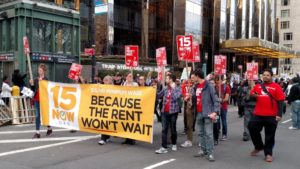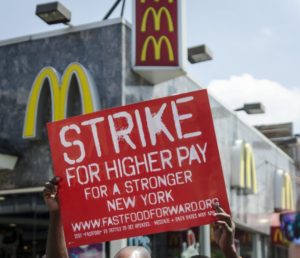
Marchers calling for a raise in the minimum wage march in front of Trump International Hotel on April 15, 2015. (Courtesy: WikiMedia)
As of 2015, 42 percent of all American workers earned less than $15 per hour. This number constitutes 2.8 million cashiers, two million retail salespersons, 1.7 million cooks, 1.5 million nurses’ aides, and 1.4 million janitors. For these individuals, worries about how to pay the bills and debates about what should get priority between food, medicine, and rent are regular occurrences.
This number — 42 percent of all American workers — also includes 48.1 percent of all female workers, 54.1 percent of all Black workers, and 59.5 percent of all Latinx workers. While 55 percent of all under-$15 per hour workers are white, African Americans and Latinx workers are underpaid at a rate that exceeds their participation rate in the labor force.
The move to raise the minimum wage in several municipalities and states to $15 per hour was applauded by advocates as a legitimate step to address this wage disparity. While at $15 per hour the minimum wage would still have less purchasing power than the minimum wage 50 years ago, the $15 per hour rate represented the first time in more than twenty years that the minimum wage exceeded the federal poverty level for a full-time worker. This was seen as the first step toward guaranteeing a living wage for all full-time workers.
For many Black workers, living on low wages is just a fact of life. Take Shamar El-Shabazz, who shared his story last year with USA Today. El-Shabazz lives in Delaware and works at a Burger King making the minimum wage of $8.25 per hour. He lives with his wife and daughter in a one-bedroom apartment and his wife has a medical condition that prevents her from working. “I’m trying to make an honest living, trying to stay out of trouble, trying to just survive the best I can without getting in any trouble,” Shabazz states. “But it’s been very difficult when you only can make so much money as a civilized person in the city.”
A new study from the National Bureau of Economic Research, however, argues that the $15 minimum wage is not the blessing it seems. Looking at Seattle, which increased its minimum wage from $9.47 to $11 per hour in 2015 and from $11 to $13 per hour in 2016, the NBER argues that the minimum wage hikes hurt and not helped Seattle’s low-wage earners. “Using a variety of methods to analyze employment in all sectors paying below a specified real hourly rate, we conclude that the second wage increase to $13 reduced hours worked in low-wage jobs by around 9 percent, while hourly wages in such jobs increased by around 3 percent,” the NBER and University of Washington working paper reads. “Consequently, total payroll fell for such jobs, implying that the minimum wage ordinance lowered low-wage employees’ earnings by an average of $125 per month in 2016.”
While the validity of the findings of this study can be argued, the study does raise several valid points. First, do minimum wage laws affect small and large employers differently, and if so, does increasing the minimum wage adversely affect small business owners and small business employees? Second, can minimum wage increases actually create high-paying jobs, and does this actually decrease the earning power of those these laws seek to empower? Finally, is there a better way to support low-wage earners?
Debating Minimum Wage
When asked, critics of the minimum wage tends to point to the concept’s origins in this country to prove how destructive they feel it can be.
The birth of the federal minimum wage was set in motion in 1895 when New York state passed the Bakeshop Act, which — while not dealing directly with wages — were a set of laws that required improvements in work conditions in bakeries and restricted employees’ maximum working hours to 10 hours a day and 60 hours a week.
The U.S. Supreme Court later struck down the act, but it did provide inspiration to Franklin D. Roosevelt when he became President— a native New Yorker — on how to deal with unemployment during the Great Depression. By introducing shorter work shifts and a minimum wage, it was thought that more jobs must be created to do the same amount of work without punishing the worker. While the initiative was voluntary, participating businesses were allowed to hang the National Industrial Recovery Act’s blue eagle in their windows as an indicator of their participation in the effort and a bulwark against boycotts from Americans who were encouraged to do their patriotic duty by patronizing blue eagle businesses.
When the Supreme Court struck down this law as well Roosevelt activated his plan B: he would use the Civil Works Administration and the Works Progress Administration to pay public works employees wages comparatively better than the rest of the public. To retain their work forces, employers were forced to pay higher wages. By 1938, with the high court newly more amenable to laws favoring labor, Roosevelt was able to engineer passage of the Fair Labor Standards Act, which set the first federal minimum wage of $0.25 per hour.
In some areas of the labor market conditions created the effect of a minimum wage decades before 1938. In the late nineteenth century, for example, African-Americans made up a large percentage of the industrial working force. In the South, for example, African-Americans made up to 90 percent of the locomotive firemen. African-Americans were able to work in these fields in such large concentrations because they agreed to lower wages than their white counterparts did. In a compromise reached between the railroad owners and the Brotherhood of Locomotive Firemen regarding restricting the hiring of non-unionized Black workers, a minimum wage was agreed on for all firemen. What this did was remove the incentive for hiring African Americans, as they could no longer underbid whites.
“The gap between black and white earnings is a longstanding feature of the United States labor market,” the NBER researchers said. “Competing explanations attribute different weight to wage discrimination and access to human capital. Using new data on local school quality, we find that human capital played a predominant role in determining 1940 wage and occupational status gaps in the South despite the effective disenfranchisement of blacks, entrenched racial discrimination in civic life, and lack of federal employment protections.
“The 1940 conditional black-white wage gap coincides with the higher end of the range of estimates from the post-Civil Rights era. We estimate that a truly ‘separate but equal’ school system would have reduced wage inequality by 40 — 51 percent.”
Those that argue against raising the minimum wage suggest that since the skill set of the average Black worker and the average white worker is not the same due to historical discrimination, raising the minimum wage would effectively “price” the underskilled worker out of the market.
“In ethically managed firms, it is very likely that highly productive employees were already being paid a wage in the $15-per-hour range — and often even more,” Timothy Wiedman, retired associate professor of management and human resources at Doane University, said to Atlanta Black Star. “If lower-skilled workers could not command wages in that range in the first place, those are precisely the sort of workers who will see their jobs disappear first when automation and/or outsourcing are introduced.”
“Having a $15 minimum wage may seem like a humane way to treat our workers — at least in the short term. But, in the longer run, the laws of economics can never be ignored in order to satisfy humanitarian and/or political goals.”

Protestors march during the 2013 fast food strike. The strike was a response to fast food companies’ rejection of minimum wage increases. (Courtesy: WikiMedia)
Limited Sample Sizes Undercuts the New Study
All of this, of course, assumes that minimum wage laws as they are implemented today are bad policy. However, there is little evidence to suggest this, despite the NBER study.
The NBER study has been argued to be analytically flawed. The study makes two assumptions that undercut its findings’ ability to be taken as valid conclusions.
First, the study only focused on small employers. By omitting employers with multiple locations, the study excluded 40 percent of Seattle’s low-wage workforce. As firms least capable of adapting effectively to shifts in minimum wage were counted, the results followed a predictable pattern. Larger firms are more likely to embrace changes in minimum wage with little or no effect on workforce strength. In 2016, for example, Walmart — the nation’s largest employer and largest payer of sub-$15-per-hour wages — agreed to increase the minimum wage at Walmart to $10 per hour or better for employees hired before January 1, 2016 and $9 per hour for everyone else. The company has also shortened the training period needed to move from $9 per hour to $10. But many of the smaller businesses the study surveyed, unable to pay the higher wages, were forced to cut jobs or reduce hours.
While it is likely that some small businesses did suffer from the minimum wage hike, it is also likely that other businesses thrived from the infusion of new cash into the local economy.
Second, the study failed to consider if Seattle was going through an employment shift outside the influence of the minimum wage. The study points to the fact that while there has not been a spike in minimum wage jobs post-hike, there has been a significant increase in jobs paying more than $19 per hour. This does not represent a loss in minimum wage jobs, but a shifting from lower paying to higher-paying jobs.
As such, it is difficult to draw clear conclusions from the NEBR study. “There are a number of methodological issues that call the results of the University of Washington study into question,” Ben Zipperer, economist for the Economic Policy Institute who co-wrote a peer analysis of the NEBR working paper, said in a press release. “There is a large body of research that shows that modest increases in the minimum wage boost wages for low income workers without causing job loss, and nothing in the UW study suggests we should revise those conclusions.”
However, the NEBR paper does beg an interesting question. If small businesses are the principal employer in this country, and if minimum wage laws are hurting them, can it be argued that minimum wage laws are bad for low-wage employees? The website ”Face of $15,” which is a project of the conservative think tank the Employment Policy Institute, posts stories of businesses affected by the minimum wage hike. In one, a Subway franchisee was forced to let go of four of her employees due to having to pay the $15 minimum wage, with her husband taking up the slack, working 60 hours a week. In another, a Brooklyn restaurant owner closed his doors because he could not pay the minimum wage. “When I told them we were closing the store a lot of tears were shed,” the restaurant owner was quoted saying.
Zipperer would argue no. “It can and should be expected that some businesses may have trouble adjusting to economic change,” Zipperer said to Atlanta Black Star. “But, for every restaurant that fails because of increased minimum wage, another thrives. “
“Bold action is needed to reverse decades of wage stagnation that have kept living standards down for low-wage workers,” Zipperer added, taken from his press release comments. “Concerns about job loss can be misleading. What’s important is, will low-wage workers be better off with a higher minimum wage? Every piece of credible research points to the answer to that question being yes.”
The Economics of Hope
The NEBR report has since been countered by a report by the National Employment Law Project, arguing that a $15-per-hour minimum wage will help lift the wages of 20.7 million.
Even if the question of if minimum wage is a valid solution toward fixing the ills of the nation’s lowest-paid workers is still an unresolved one, the need to secure a living wage for every working full time is clear.
“A full-time job shouldn’t mean a life in poverty,” Chris Lu, former deputy secretary of labor under the Obama administration, wrote for Time. “The federal minimum wage amounts to just $15,080 a year for full-time work. That translates into declining living standards, reduced economic mobility and a shrinking middle class. It mires workers and our economy in an impoverishing cycle created by inadequate pay. Far too many workers earning minimum wage turn to government assistance and food pantries to make ends meet.”
With nearly half of all working Americans receiving wages that place them within 133 percent of the federal poverty level, most would agree that a solution must be found. However, the odds of this solution coming from Washington is a slim one. Donald Trump has offered contradictory statements on this issue, and the congressional Republicans have shown a strong disdain for increasing the federal minimum wage.
The problem with this is that Trump and the congressional Republicans have shown disdain for other options to elevate the nation’s lowest wage earners as well. Trump’s proposal for tax reform would eliminate the Earned Income Tax Credit, a relief program for wage earners that sets a de facto basic guaranteed wage that is adjustable for family size. The EITC is credited for being one of the most efficient methods introduced to close the income gap.
However, with this credit in danger of exclusion, as well as funding for job training and non-white entrepreneurial support, the need for clear leadership in this matter is more evident than ever. With many Americans yet to see any true sign of economic growth or relief eight years following the end of the Great Recession, solutions such as $15 per hour minimum wage may be imperfect, but it may be the best solution currently being offered.


